- Complete Guide to (57) Almost All Types of Fiber Arts with Photos
- What is Sheep’s wool used for? 53 Great Possibilities
- Yay! the 1 Best Answer to – define the term, fiber. name the four techniques of art that use fiber.
- What is considered fiber art? Expert Answer 5 Little-known Factors
- Mastering Art: How To Make Fabric From Fiber, A Comprehensive Guide
- The Ultimate Encyclopedia of Animal Fiber: Everything You Need to Know
Animal Fiber: Everything You Need to Know
The handler cued the dog and the slim bi-blue Border Collie took off like it had been launched. In a wide arc, it rounded on the flock of Katahdin sheep, then suddenly halted, flattened on its belly, and slowly began to inch forward. The fluffy white animals huddled together and scurried away from the crouching predator.
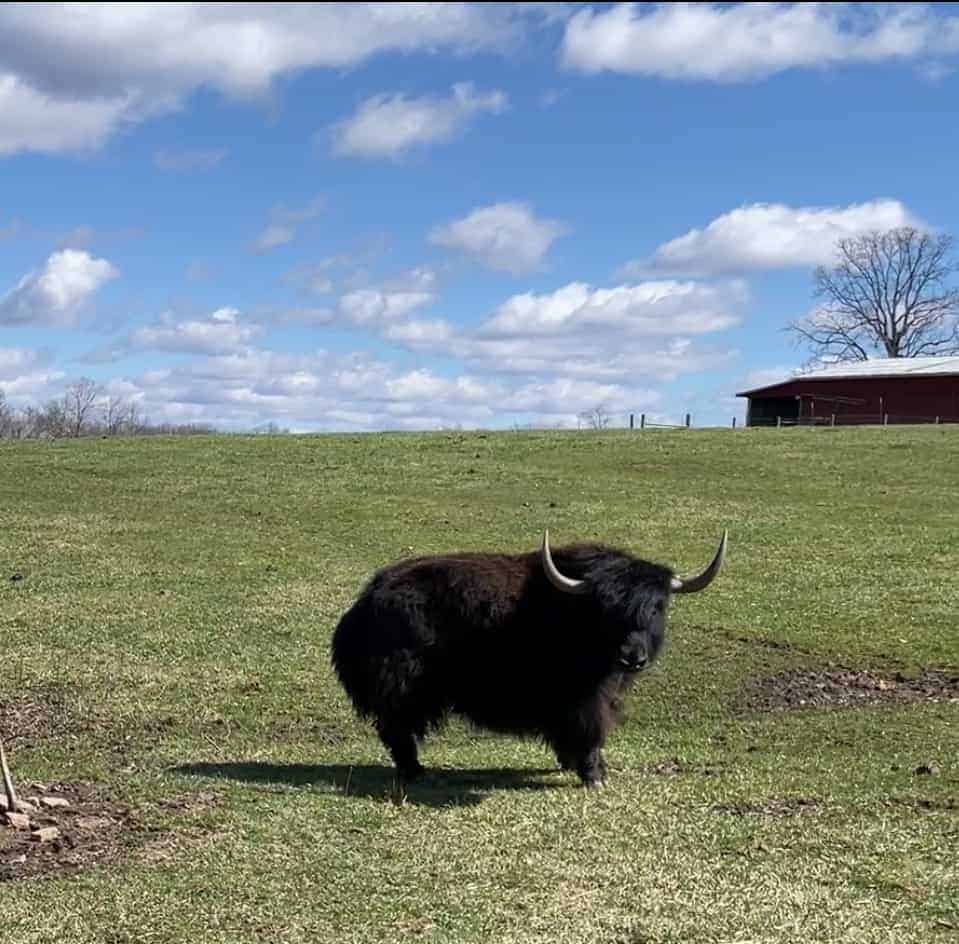
The sheep were already shedding their winter coats. This is unusual for sheep, but Katahdins are what’s considered a primitive breed. Their wool can still be useful if you collect it.
For thousands of years, we humans have found ways to survive in a world that can be bitter and unforgiving. By and large, we’ve been successful, so successful we’ve managed to domesticate a few other animals along with ourselves. In that process, we’ve discovered that their ample hair can help us keep warm too.
Animal fibers have been so important to human survival and flourishing, it’s unlikely that we could have come as far as we have without them. Wool, for example, wicks moisture and has immense insulating properties. It’s also fire-resistant. It’s used for clothing, footwear, gaskets, insulation and even housing.
Silk is deliciously soft, with a sheen that’s made it the envy of royalty. It’s also one of the strongest fibers in nature. Silk has also been the most common fiber for medical stitches over the past 100 years.
It should come as no surprise that animal fibers have been popular natural choices for textiles, and will likely remain so in the future.
This is barely scratching the surface of how many animal fibers there are and everything they can do. In this article, I am going to explore every animal fiber that I can get my hands on. Each type will be linked to its own deep dive covering properties of the fiber and the animal that produced it.
This is going to take some time to finish, so check back regularly to see updates on new fibers.
General pros and cons of Animal Fiber
While each fiber is unique, there are some things that are generally true of most animal or protein fibers. These can be thought of as ways animal fibres are distinct from either plant fibers or synthetic fibers.
- 1) Warmth retention – animal fiber holds more warmth
- 2) Fire resistance – animal fiber is less flammable
- 3) Fiber Strength – animal fiber is weaker
- 4) Fiber elasticity – animal fiber is more elastic
- 5) Comfort – animal fiber is more comfortable in cold conditions
- 6) Absorbs moisture – animal fiber holds more water while still feeling dry
- 7) Wicks moisture – animal fiber wicks away more sweat
- 8) Resists odors – animal fiber takes longer to absorb body odor
- 9) Shrinks in washing – animal fiber is more likely to shrink in hot water
- 10) Resists abrasion – animal fiber is better at holding up to wear
- 11) Pilling – animal fiber is more likely to pill
- 12) Wrinkles – animal fiber is less likely to wrinkle
- 13) Insect damage – animal fiber is more likely to be damaged by bugs
- 14) Fungus vulnerability – animal fiber is less likely to suffer fungus damage
- 15) Acid damage – animal fiber is less likely to be damaged by acid
- 16) Alkali damage – animal fiber is more likely to be damaged by alkalis like bleach
- 17) Feltable – animal fiber is much more likely to felt
- 18) Breathable – animal fiber is more breathable
The Ethics Question
Today more and more people are questioning animal welfare in the keeping of domesticated livestock. The good news is that by and large domestic animal care has improved greatly. Healthy comfortable animals grow better fiber, produce more milk, and require less medical treatment.
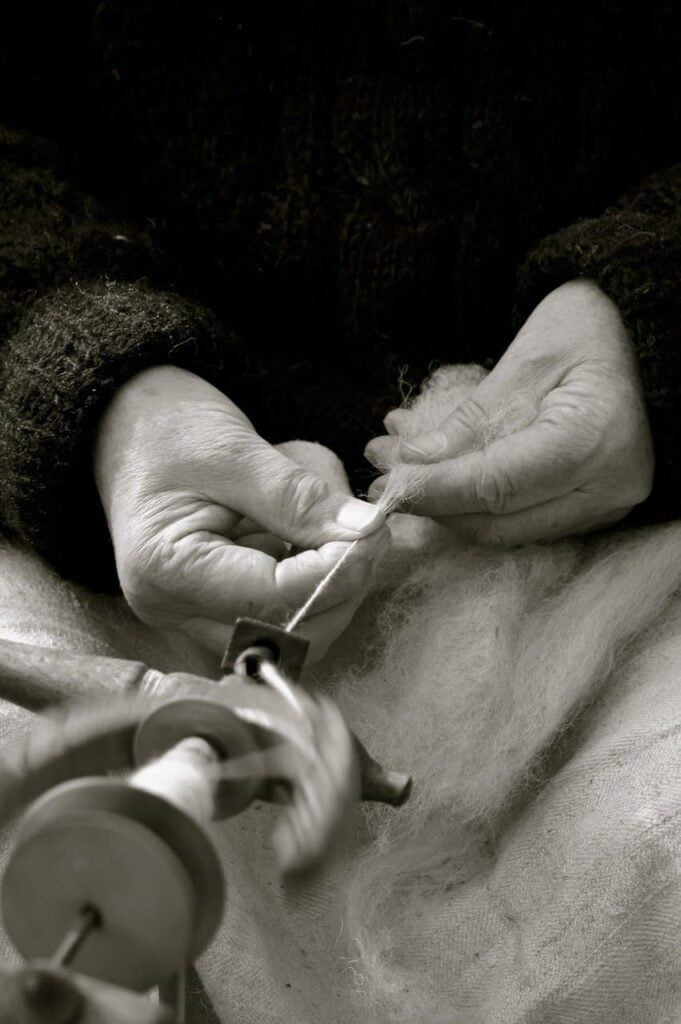
The point of this article is not to debate that question, but rather to present the unique characteristics of each fiber and the animal it comes from. That way individuals can decide the pros and cons of each for themselves.
As in other areas of life, there are no easy answers. Farmers have to make difficult decisions based on their individual circumstances. Likewise, individuals have to choose between natural fiber and synthetic fibres. We each have to balance what we can afford vs the task we need fibers to perform.
Even plant and synthetic fibers have significant drawbacks. At the same time, we humans have managed to forge some amazing symbiotic relationships all ’round.
We can make clothing from sheep wool and survive cold winters. Those sheep need to be sheared by people or they risk overheating and losing mobility from the weight of their wool. Much like cotton and flax also need human care to maintain their growth.
Humans, animals, and plants have survived and adapted to life together, however imperfectly. We can continue to strive for new ways to produce more responsible animal fiber as we advance. Fiber art, with its twisting, interlacing, knotting, and binding together to create warmth and protection is a brilliant metaphor for how we can thrive interdependently.
Fur, Wool, or Hair
Before we discuss individual animals, I want to take a moment to clarify what we are talking about when it comes to animal fiber.
All mammals have hair. That’s one of our defining features, even if the hair is temporary, very thin, or sparse. I’m looking at you elephants, whales, hippos, and rhinos.
Some animals, especially those from cold climates will have different types of hair that layer over each other to retain warmth. A good example would be Siberian Husky dogs.
They have a double coat, consisting of long coarse outer guard hairs and a soft downy undercoat of short thin hairs with a little bit of crimp.
As this article from Live Science points out, hair is what we consider the ‘basic unit’. On our husky dog, it would be correct to call either the guard hairs or the undercoat, ‘hair’.
Fur, in contrast, is a word that describes dense short hair that covers the animal’s body. Rabbits, for example, are described as having fur.
Wool is actually a type of undercoat. That is why wools are often curly, soft, and thin. Unlike most undercoats, wool never stops growing and it doesn’t shed.
With these distinctions in mind, let’s dive into all the different types of animal fibre.
Types of Animal Fibers
Each animal fiber will be listed here with a brief description of the highlights. Click through to see a deep dive on each fiber. This is a work in progress, so check back regularly to see information on new animal fibers! Plant fibers and synthetic fibers will have their own posts
Birds
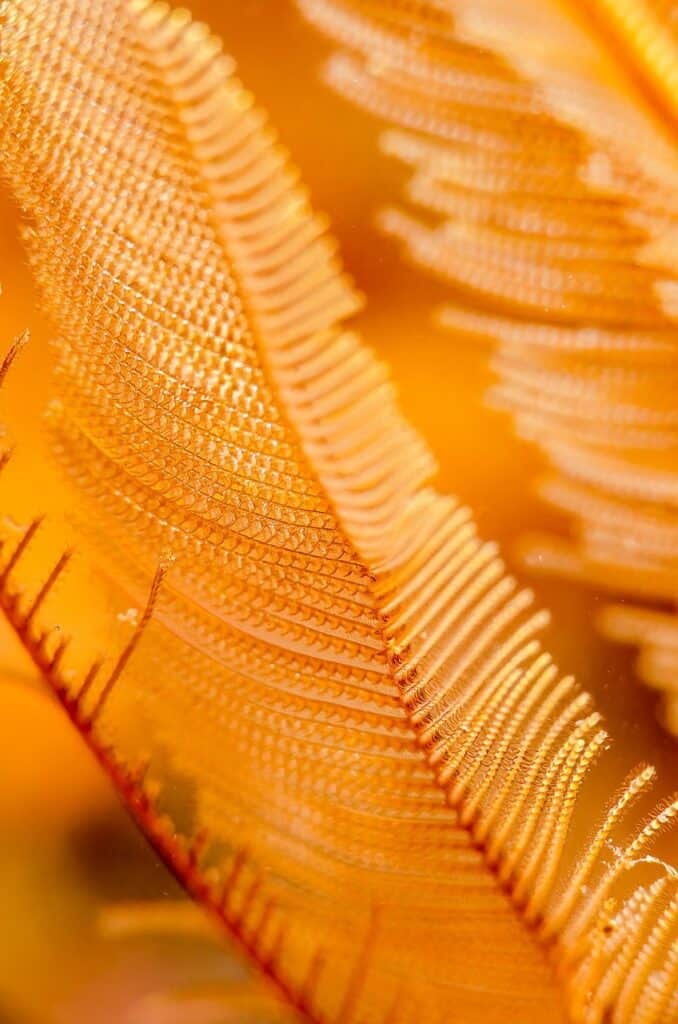
While not typically considered a fiber animal, bird feathers have been used as an additive to other rovings and batts for a long time. Feathers can not only be very insulating, but they can also be very durable.
Fluffy down feathers in particular have a similarity to the wooly undercoats of many mammals. For my fiber test, I will attempt to spin the down as you would cashmere.
I will also see how they do with a felted treatment.
duck down
goose down
Bovines
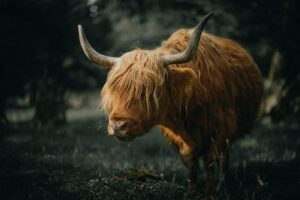
The vast majority of cattle have short fur that is not long enough to be spun or felted. There are a few exceptions though. Bison, Yak, and Highland Cattle are all double-coated fiber animals.
Their longer guard hair can be used for things like twine or rugs. The soft undercoats, particularly the bison and yak make for premium fiber. This soft down is comfortable close to the skin and is comparable with cashmere.
Of the three varieties of Bovines that do have workable wool, all are hardy breeds that do well in difficult, particularly cold environments.
Bison
Highland Cattle
Camelids
Camelids are a unique group of animals. There are only seven different types of Camelids in the world today and they cluster naturally in the Middle East, Asia, and South America.
Some scientists consider them living fossils as they are the remaining descendants of a line of animals that has largely died out. In addition, the current varieties which have survived are structurally very primitive. Which is to say camels today look a lot like the bones of camels millions of years ago.
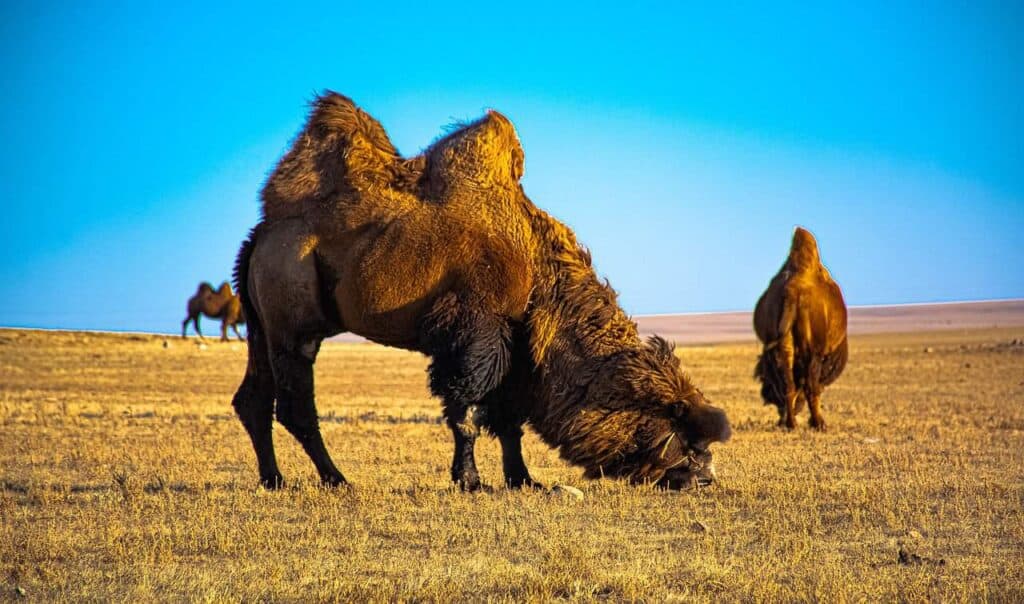
There is also a considerable history of domestication among Camelids. Dromedary camels are entirely domesticated and no wild populations remain.
Bactrian camels, Llamas, and Alpacas are the domesticated versions of their wild counterparts, the wild Bactrian camel, Guanaco, and the Vicuña.
From a fiber standpoint, Camelids have a lot to offer. Camel wool or down is a soft fine luxury fiber. Alpaca, particularly the Suri alpaca variety have a very fine coat. Suri alpaca fiber does not have crimp.
Camelids, particularly those from Asia, do have guard hair that has to be removed by hand which can be time-consuming. These guard hairs along with the more wooly fibers are feltable.
Most camelids have worked as pack animals alongside humans. Dromedary and Bactrian camels are favored for crossing the desert. In South America, the llama excelled a carrying loads through mountainous terrain.
Of the domesticated Camelids, the alpaca is notable for being primarily kept as a fiber animal. To this day alpaca fibre is prized as a luxury.
Alpaca
Huacaya
Suri
Camals
Dromedary
Bactrian
Guanaco
llamas
vicuña
Canine
Most folks think of canine hair as an annoyance that must be removed with heavy-duty vacuums or regular trimming. Often considered fur, some dogs and wolves are double-coated with a soft downy undercoat that sheds at least once a year.
Canine fiber, like that of all animals who live closely with humans, has in turn been used to make yarn, slippers, and even sweaters.
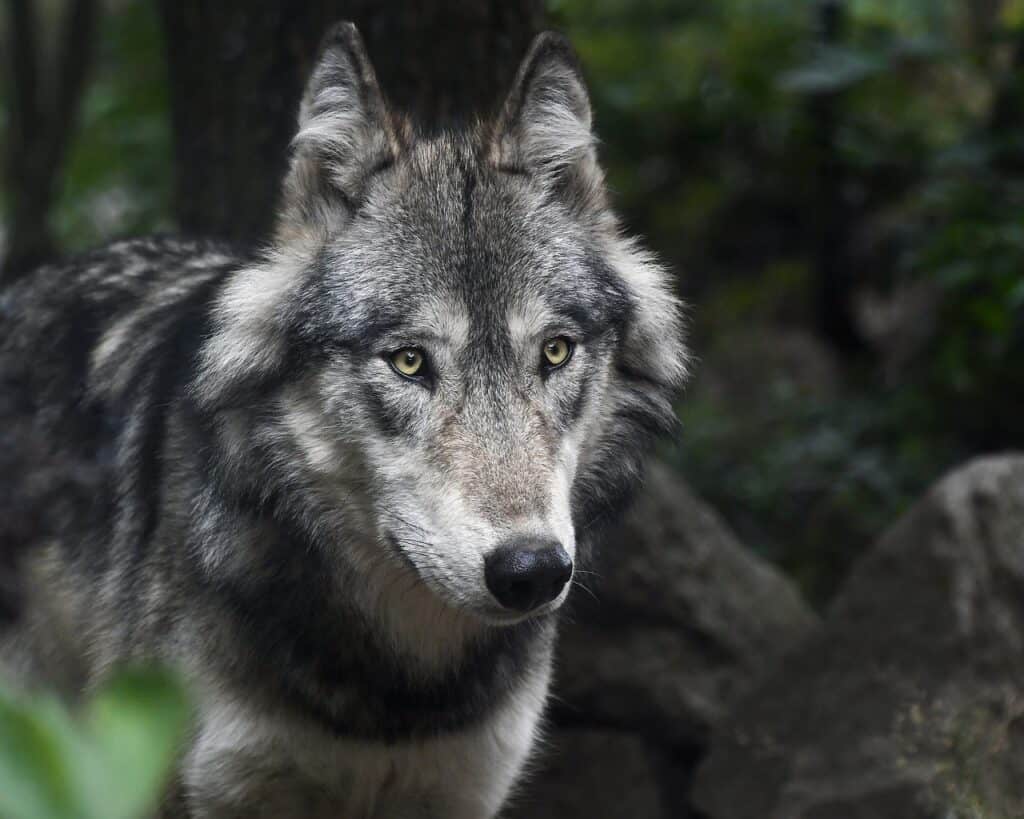
Dog breeds like the Chow Chow, Samoyed, and the Bernese Mountain Dog have long undercoats. These are most easily adapted to typical fiber uses, like spinning.
In the past wolves were seen as a direct threat to human and livestock survival. Their pelts would have been used to make hats, leggings, coats, and hoods. In parts of Alaska, this is still an essential part of the Inuit and Athabaskan traditions and a necessity in that bitter cold.
However modern developments have allowed for a softening of the natural antagonism we feel for other predators. Not only has this allowed for the reintroduction of wolves to parts of their natural range, but it has also meant some wolves and hybrids have been saved in sanctuaries.
Wolves kept in rehabilitation centers and rescue centers mean that at least from time to time their undercoat hair is available as it sheds.
Wolf down most likely has many of the same properties of a dog undercoat, and we will be finding out. Major questions include does wolf fiber smell like dog?
Dogs – Why is it bad to shear some dogs? Guard hairs and undercoats.
Wolves
Cats

Cats for the most part have short furry coats. Though there are some domestic cats, like the Persian, which should produce spinnable wool. It’s up in the air as to whether I will test this fiber, as I am miserably allergic to cats. Nevertheless, data will be collected and I’ll keep you posted.
Goats
Though uncommon as domestic livestock in the United States, goats are plentiful around the world. Because they can survive where larger animals like cattle cannot, they have been used for meat, skins, milk, transportation, and their fiber.
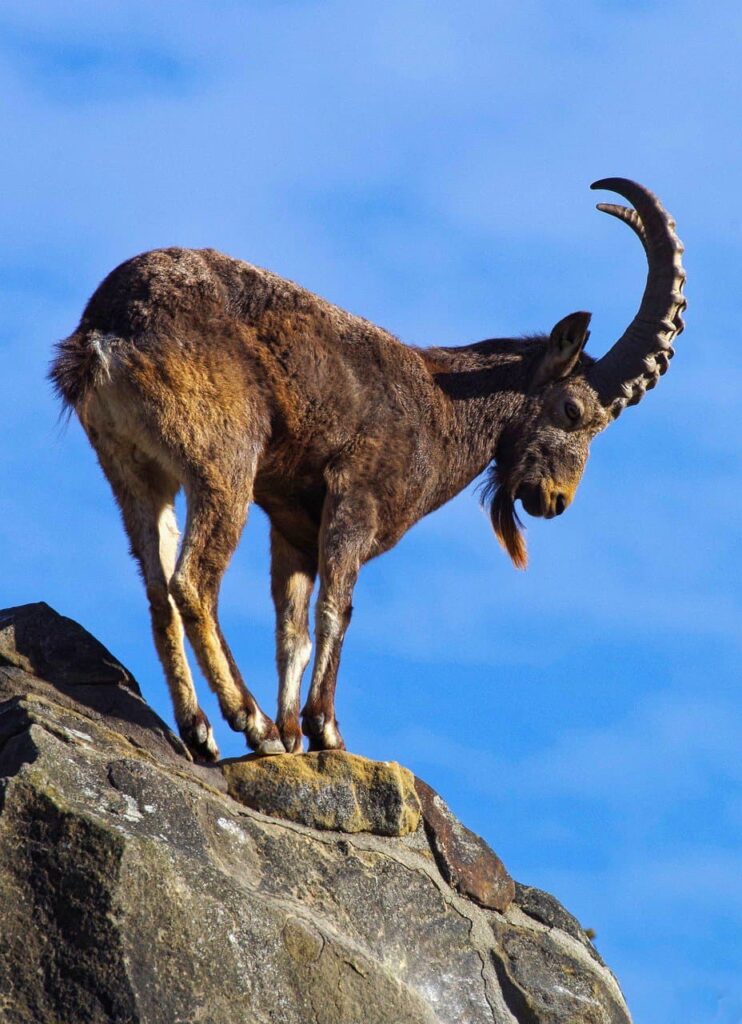
The goat’s ability to survive even in harsh mountain climates has produced an animal that grows some of the most sought-after fiber in the world, cashmere.
While any goat, save the Angora goat, can grow cashmere, some have been carefully bred to produce larger amounts. Known as the cashmere goat, they are prized throughout the world.
Cashmere wool or fiber, is the downy undercoat that sheds in mid-spring. As a double-coated animal, cashmere wool does have to be de-haired to get the full benefit of this delicate natural fiber. Unlike sheep, they do not require shearing.
The Angora goat, on the other hand, is the source of mohair. Angora goats must be shorn twice a year. Angora fiber has luster and grows in large ringlets over the goat’s body. These ringlets of angora wool are actually the undercoat fibers and this is also known as mohair.
Mohair is believed to be one of the oldest textile fibers. It is naturally warmer than similar fibers and it takes dye well. Young goats produce the softest mohair. Baby mohair is used for garments. Mohair from older animals is often more suited to outerwear or rugs.
Questions sometimes come up regarding the term pashmina. Pashmina is a poorly defined term. It is not legally recognized in the US as a labeling term. Worldwide it is often synonymous with cashmere. However, it is also used as a term for cashmere blended with silk.
This confusion, along with synthetic fibers also being labeled as pashmina, has watered down the term to the point of uselessness.
Goat crosses like the Cashgora, Pycazz, PCA, Nigora, and Pygora represent new frontiers in goat fiber.
Cashgora
Cashmere
Mohair
Nigora
PCA
Pycazz
Pygora
Horses
To be a bit on the nose, throughout history horsehair has been a workhorse fiber. It was used as insulation, upholstery stuffing, bedding, and brushes.
Mane and tail hair were used as lace support fibers or stiffened for dressmaking. Yet the advent of cars and the invention of Nylon has all but eliminated the use of horsehair commercially.
The last significant use of horsehair is in the bows of string instruments, from violins to stand-up basses. Yet if you have horsehair handy it is as useful as any other animal fiber, and maybe even more useful than some.
Horsehair
Insects
Few think of insects as a source of fiber, but silk, one of the most sought-after luxury fibers is the product of a caterpillar. A lustrous protein fiber, silk was so important to ancient trade that the Silk Road, was named for it.
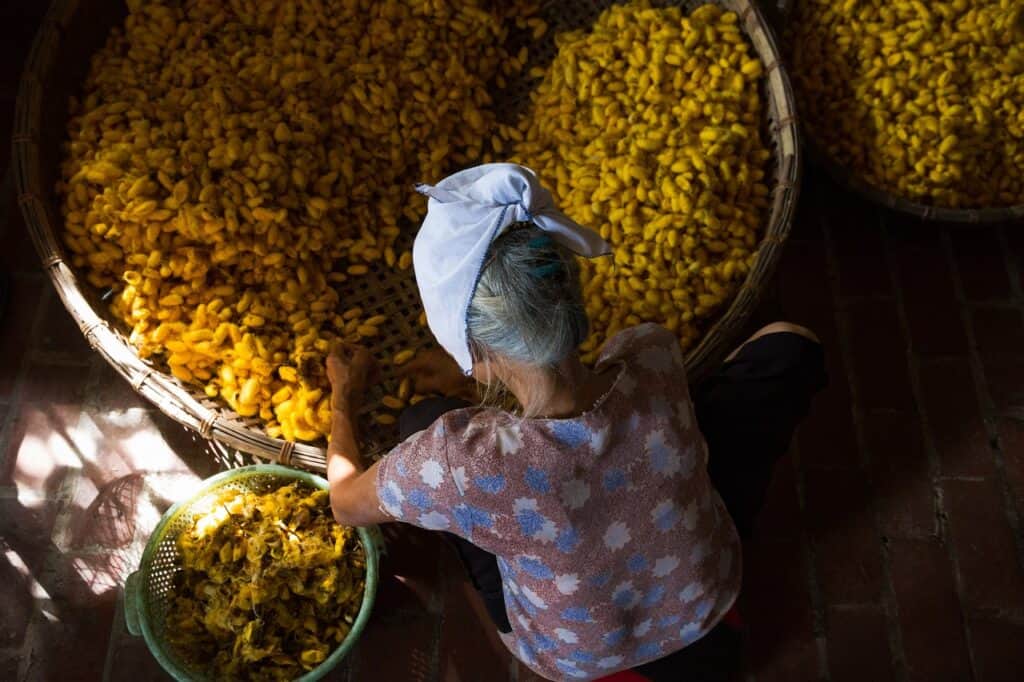
Domesticated over 5000 years ago, the modern species of silk moth, Bombyx mori, is flightless and entirely dependent on human care to survive. The silk moth’s life cycle is between six to eight weeks.
Silk comes from the cocoon of the caterpillar which is produced as a single thread measuring 1000 to 3000 ft (300 to 900m) long. To harvest the silk, the cocoons are boiled in water, this degums the fiber, but also kills the insect.
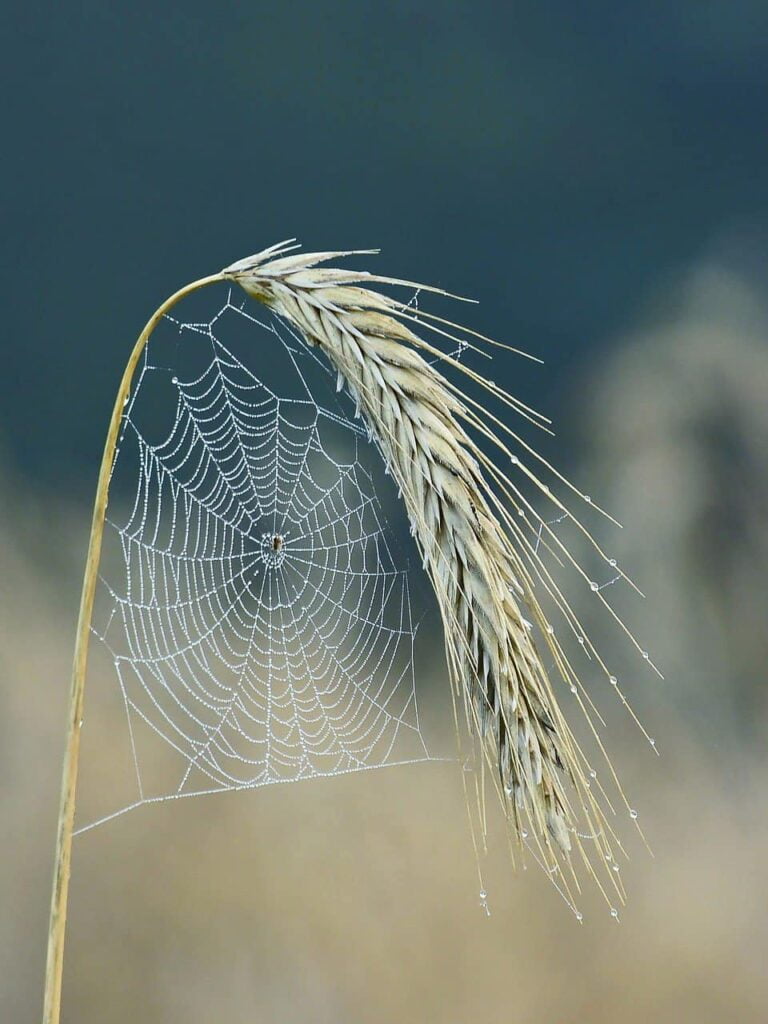
Silk moth larvae are edible and in some areas the the cooked silkworm has become something of a delicacy. In other areas, this has become a point of contention, most notably with Gandhi who followed a philosophy that directed, “not to hurt any living thing.”
Sik’s fine quality and flexibility have made it a desirable material for surgical sutures.
A distant relative, spider silk is much more rare as a textile fiber. Francois Bon made the first attempt to weave spider silk fabric, producing stockings and gloves.
Spider silk is difficult to harvest and process and this has severely limited its use. One notable exception was a large 11-by-4 foot (3.4 by 1.2m) tapestry made from golden orb-weaving spider silk and finished in 2009.
Silk (Bombyx)
Spider Silk
Musk ox
Musk ox are native to Alaska and the far Northern reaches of Canada and Greenland. More closely related to goats and sheep than to cattle. The male musk ox has horns that come together over the top of the male’s head forming a thick plate called a boss.
Musk ox grow several different kinds of fiber, but they are most revered for their undercoat which is known as qiviut. This soft downy hair is finer than cashmere and is a greyish brown.
Qiviut is shed once a year in the springtime and must be de-haired before it can live up to its potential. Most qiviut available is obtained from shedding musk ox and the animals are not sheared.
Occasionally it comes from the pelts of hunted musk oxs in Canada. The pelts are sheared and the resulting fiber must go through significant de-hairing.
Qiviut
Rabbits
Rabbits are a unique source of animal fiber. Angora rabbits in particular have become a significant fiber producer.
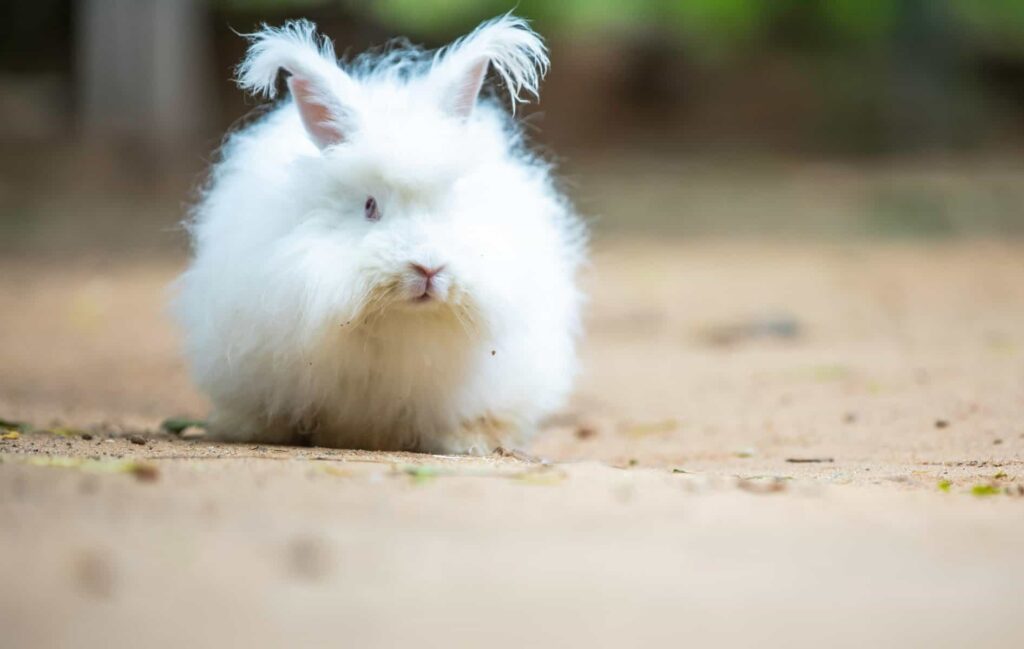
It is unclear where Angora rabbits developed. Some believe them to have come from Turkey as the name would suggest. Others say they are from Great Britain and that exporting prohibitions led to traders making up the name.
We do know they became popular in France in the early 1700s where they were bred and developed for two centuries.
While most rabbits have short hair, the Angora rabbit has a wooly coat that averages between 14 to 16 microns in diameter, giving it a softness similar to cashmere.
Angora rabbits require regular grooming to prevent overheating and matting. Commercially kept angora are shorn every three to four months. Pet rabbits who are not shorn need to be groomed at least twice a week.
Angora fiber does not have crimp and may be slippery and difficult to spin. While Angora fiber comes in four different types, guard hairs, undercoat, awn hair and down, these fibers are not often separated but are spun together.
Angora
Rodents
In the past, rodents were a staple of the fur trade. Their short fur was often very soft and superior at retaining warmth in harsh conditions. With modern advances in indoor climate control, animal fur is increasingly being avoided in favor of plant fiber and synthetic fiber alternatives across the world.
Today rodent hair is now being used as a fiber, as opposed to a pelt. Currently, two rodents have developed into fiber animals, brushtail possums, and the chinchilla.
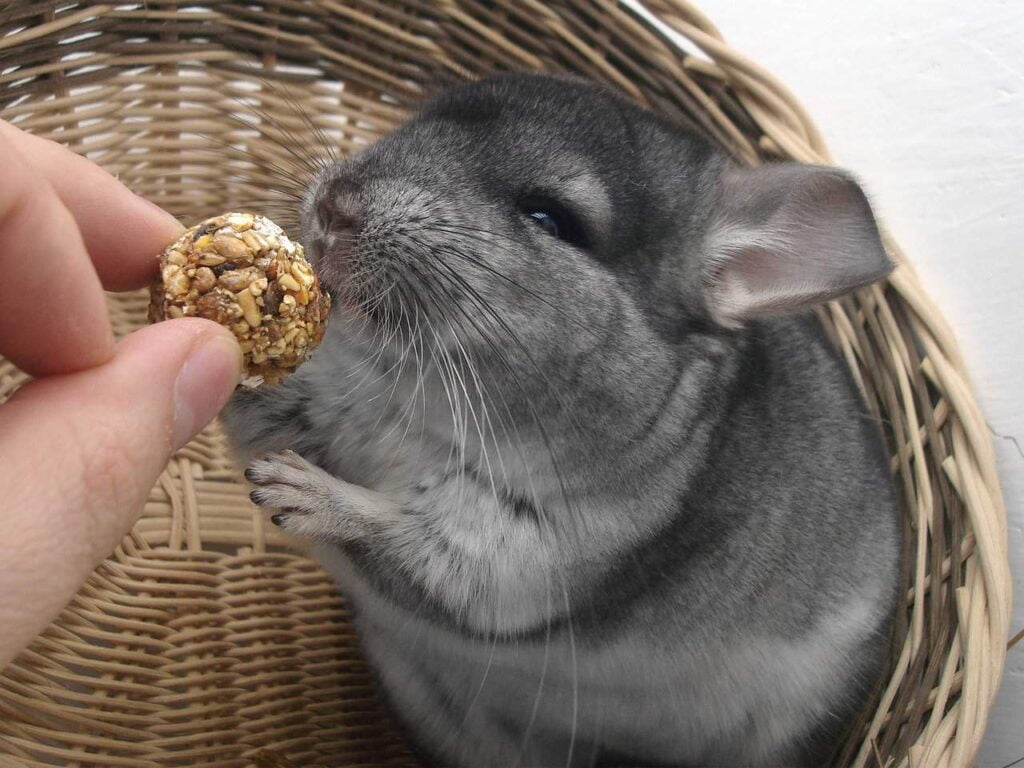
Brushtail possums are an Australian animal. Introduced to New Zealand as part of the fur trade, they have become invasive, damaging native plants and out-competing native fauna for food and territory.
Today populations are controlled by culling. The fibre of culled possums is put to use as a luxury item. Possum fiber is very soft, resists pilling, and is anti-static.
The shaft of possum fiber is hollow, which makes it very light and also insulating. By most reports, it is warmer than cashmere. It does have a very short staple length that requires blending and adjustments in spinning. Much like mohair, possum fiber creates a halo in the finished fabric
Chinchillas are rodents native to the Andes in South America. Once a sought-after source of fur, they have become popular as pets. Twice a year they shed their coats and this fiber can then be spun or used in other ways.
Chinchilla fiber is very short, with a 1.5-inch staple length and an incredibly soft 13-micron width. Because the fiber is so short, it also forms a halo when worked.
Chinchilla
Possum
Sheep
Sheep wool is of course the largest category of animal fiber. Worldwide, sheep are the foremost fiber-producing animal. It’s unknown how many breeds of sheep exist. Estimates range from 1000 to 1400. Many of these breeds are rare and verging on disappearing.
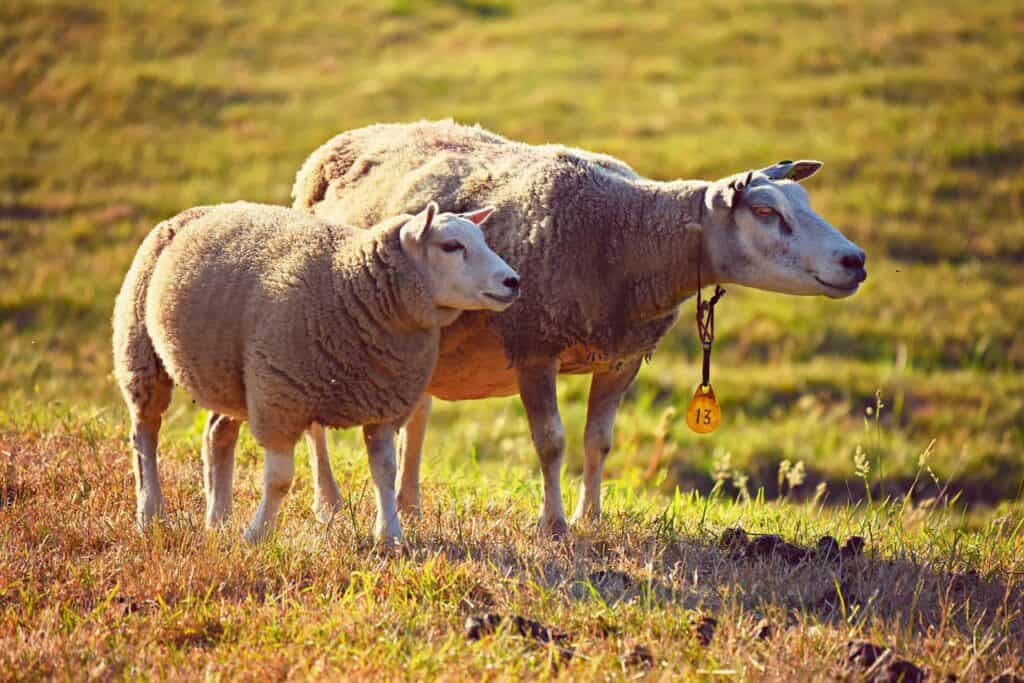
While saving wild animals from extinction is straightforward for most people, it can be out of the ordinary to think that livestock breeds can also disappear forever, taking their unique characteristics with them.
In a world where modern farming tends to create potentially unstable monocultures, it is worth considering the value that each different type of sheep brings to the picture.
Traditionally wools have been broken down into Carpet wools and Hosiery wool. Carpet wools, as you might expect are coarse and best suited to hard-wearing jobs like rugs and saddle blankets. They are strong fibers and often lustrous.
Hosiery wools are high crimp elastic wools. They are typically matte and are considered general application wools. They can be used for blankets, sweaters, socks, or other items short of luxury uses.
There are two other categories we will add to this. Hair wool or hair sheep, and luxury wool.
Hair sheep, like the Katahdins mentioned in the introduction, are considered more primitive. While they are considered a meat sheep, they do have both outer hairs and soft downy undercoats. Hair sheep shed their fiber yearly. This makes collection more difficult but not impossible and the resulting fiber is usable.
Luxury wool includes fine wool sheep like Debouillet, Rambouillet, Cormo, and Merino. These wools are very soft to the touch and are close to cashmere in comfort. Lightweight, these fibers are ideal for delicate items like lacy shawls, or fine garments worn close to the skin.
Sheep Breeds <- Individual breed studies will be forthcoming in the future.
Forbidden Fibers
Some of the finest fibers are no longer available. Animals that need browsing diets or other special conditions are difficult if not impossible to domesticate. In the case of such animals that also grew luxurious fiber, this led to hunting.
In the past, hunting of fiber animals resulted in the near extinction of Vicuña and the Chiru. To protect the remaining populations, trade in both fiber was declared illegal, and punishable with prison time and mandatory fines.
While the Vicuña population has been recovered and methods developed to safely sheer the animals, Chiru undercoat wool, or Shahtoosh, remains illegal. Reportedly Chiru numbers have been increasing, but the political tensions around Tibet make it difficult to verify these findings.
It is also unclear if Chiru could ever be safely shorn, leaving them at risk of poaching for the foreseeable future.
While our relationships with the animals around us have been fraught and changed through the millennia, we do still need each other. In many ways today’s focus has shifted to finding methods to preserve rare species and breeds, even as we search for new ways to maintain our interdependence.
While falling somewhere short of perfection, animal fibers and related materials are popular natural choices for all kinds of uses.
References
Barber, E.J.W. (1992). Prehistoric textiles: The development of cloth in the Neolithic and bronze ages with special reference to the Aegean. Princeton University Press.
Cashmere comes from goats!?. Cashmere Goat Association …Cashmere comes from Goats!? (n.d.). https://cashmeregoatassociation.org/post.php?pid=3#:~:text=Cashmere%20is%20the%20goat’s%20soft,produce%20it%20in%20significant%20amounts.
Glaves, J. (2020, September 4). Spinning the unusual: Chinchilla, Cactus Cotton, and Spanish moss. Spin Off. https://spinoffmagazine.com/spinning-the-unusual-chinchilla-cactus-cotton-and-spanish-moss/
Harvardgazette. (2009, September 10). Oldest-known fibers to be used by humans discovered. Harvard Gazette. https://news.harvard.edu/gazette/story/2009/09/oldest-known-fibers-discovered/
Inside the illegal trade of $20,000 shawls made from an endangered animal. VICE. (2021, December 7). https://www.vice.com/en/article/y3vvay/endangered-species-animal-most-expensive-wool-illegal-black-market-fashion
Robson, D., & Ekarius, C. (2011). The Fleece & Fiber Sourcebook: More than 200 fibers from animal to spun yarn. Storey Pub.
Stephanie Gibeault, Ms. (2018, July 20). Make yarn from dog hair: Here’s how much you’ll need. American Kennel Club. https://www.akc.org/expert-advice/lifestyle/make-yarn-from-dog-hair/#:~:text=But%20just%20like%20those%20fuzzy,been%20doing%20it%20for%20centuries.
